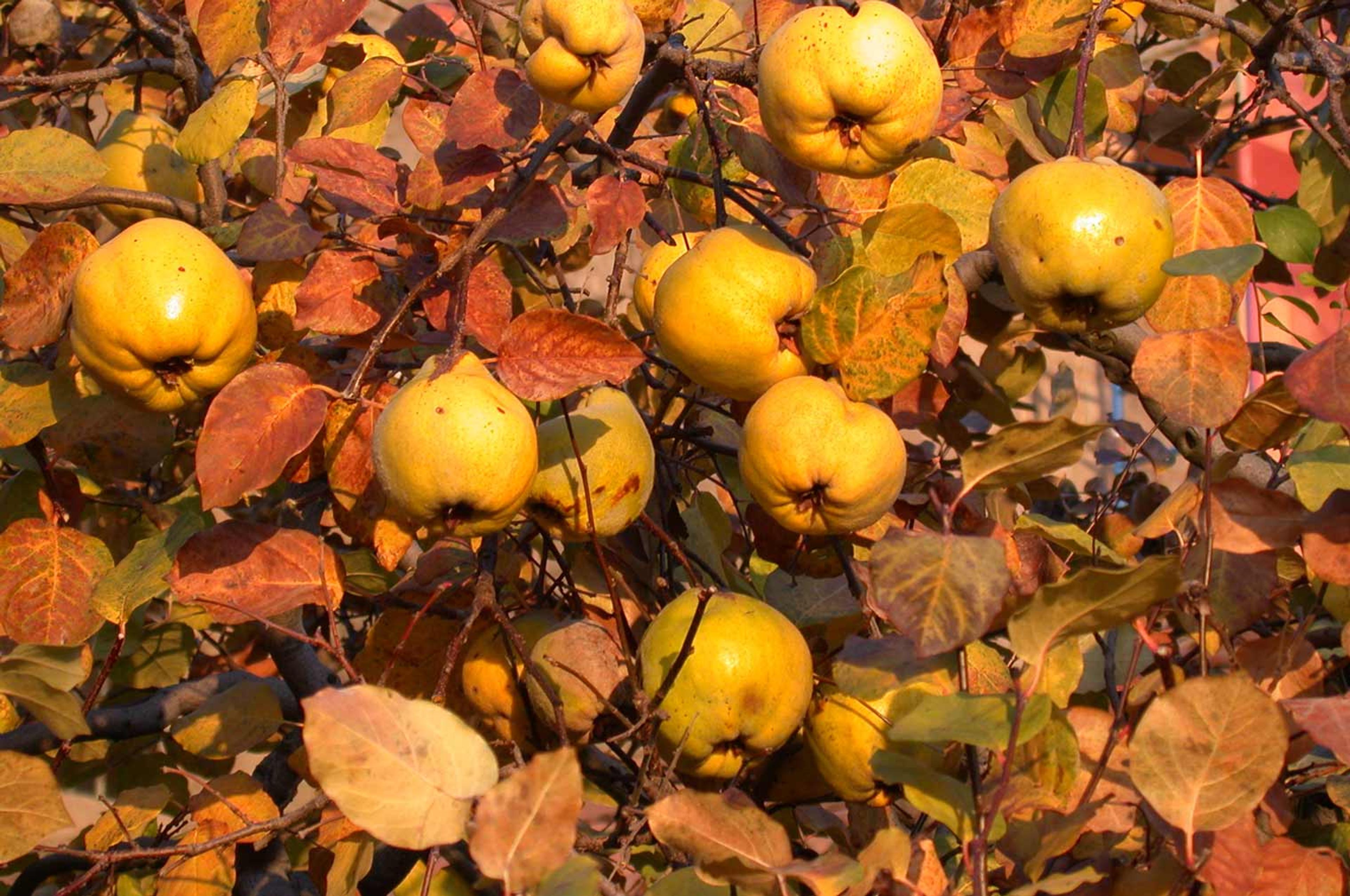The Medieval Garden Enclosed—The Golden Quince
Ripe quinces in late October. The fruit of the quince does not ripen until well into October, when the fruit loses the whitish fuzz that coats it through much of the growing season and turns a golden yellow. The delicious scent of the ripe fruit perfumes the cloister

The famous quince trees that grace the four beds at the center of the Bonnefont Cloister Herb Garden have grown there since the early 1950s. Although the trees are showing their age, they still bear a heavy crop so heavy that it is necessary to thin the fruits in late summer and to prop up the aging boughs to help them to bear the weight of the fruit. The quinces are not harvested; the fruits are picked up as they fall. Closely related to apples and pears, quince (Cydonia oblonga) is a distinct species whose fruits have an irregular shape, a wooly white coat when green, a bright golden color when ripe, and a delicious perfume all their own. (Quince is the sole member of the genus Cydonia; flowering quince (Chaenomeles japonica), a shrub grown for its coral-pink flowers, does bear a small quince-like fruit, but is another species altogether.)
Quinces are said to ripen early and well enough to be eaten out of hand in warmer climates, but in northern Europe and here in the United States, they are still quite hard, dry, and astringent when they finally begin to grow golden and aromatic in the second half of October. For this reason, quinces are usually eaten cooked, not raw. Quinces have a lot of pectin, and make excellent jams and jellies. They can also be made into quince paste (membrillo in Spanish, cotognata in Italian, cotignac in French). In the Middle Ages, this stiff conserve was pressed into boxes or fancy forms, sliced, and eaten with the fingers as part of the dessert course (Alan Davison, The Oxford Companion to Food, 1999). Nowadays quince paste is often served as an accompaniment to cheese. While the sweetened fruit may be baked in pies and tarts, there are also many savory recipes that combine quince with poultry and with meat.
Quince appears in a famous ninth-century edict, the Capitulare de villis, in which the emperor Charlemagne decreed which plants were to be grown on the imperial estates. It is one of several kinds of fruit trees shown growing in the orchard-cemetery of the monastery on the ninth-century plan of St.Gall, a very beautiful way of carrying out the idea that the monks would enter Paradise when they died.
Native to the Caucasus, quince was widely distributed throughout the Mediterranean in antiquity. The modern name of the genus comes from the ancient city of Cydonia (modern-day Khania) in Crete, where quince trees grew in abundance. The identification of the quince with the golden apples of the Hesperides was made in antiquity by the Greek botanist Theophrastus. The quince was also identified with the golden apple awarded to Aphrodite in the Judgment of Paris, and was sacred to the goddess of love and fertility. According to the ancient historian Plutarch, the Athenian lawgiver Solon directed that a bride should nibble at a quince before entering the nuptial chamber, a symbolism that was recreated in the Renaissance. (Mirella Levi D'Ancona, The Botanical Garden of the Renaissance, 1977.)
Quince has a long history of medicinal use. The ancient Greek herbalist Dioscorides, whose De Materia Medica was influential throughout the Middle Ages, recommended the fruit as a diuretic, a styptic, and an astringent; it was also used to counteract dysentery and as a poultice for inflamed breasts. (Frank Anderson, German Herbals through 1500, 1984.) The mucilage from the seed coats has humectant and emollient properties and is used today in natural cosmetics.
Deirdre Larkin
Deirdre Larkin is the managing horticulturist at The Met Cloisters museum and gardens.